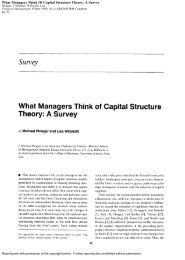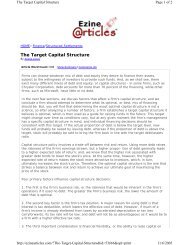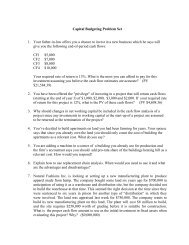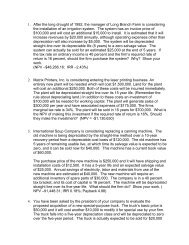Investors Must Recall Risk Investing's Four-Letter Word
Investors Must Recall Risk, Investing's Four-Letter Word
Investors Must Recall Risk, Investing's Four-Letter Word
- No tags were found...
Create successful ePaper yourself
Turn your PDF publications into a flip-book with our unique Google optimized e-Paper software.
The Wall Street Journal Interactive Edition -- January 23, 1998<br />
<strong>Investors</strong> <strong>Must</strong> <strong>Recall</strong> <strong>Risk</strong>, <strong>Investing's</strong> <strong>Four</strong>-<strong>Letter</strong> <strong>Word</strong><br />
By KAREN HUBE Staff Reporter of THE WALL STREET JOURNAL<br />
What four letter word should pop into mind when the stock market takes a harrowing<br />
nose dive? No, not those. R-I-S-K. <strong>Risk</strong> is the potential for realizing low returns or even<br />
losing money, possibly preventing you from meeting important objectives, like sending<br />
your kids to the college of their choice or having the retirement lifestyle you crave. But<br />
many financial advisers and other experts say that these days investors aren't taking the<br />
idea of risk as seriously as they should, and they are overexposing themselves to stocks.<br />
"The market has been so good for years that investors no longer believe there's risk in<br />
investing," says Gary Schatsky, a financial adviser in New York. "And when the market<br />
drops hundreds of points and rebounds immediately, that belief is confirmed." The<br />
danger is that when the market declines and stays down for months -- as some analysts<br />
predict it eventually will -- investors won't be able to meet their short-term financial<br />
goals. Or, they will panic and sell their investments as their shares are declining in value,<br />
which is the worst possible time. So before the market goes down and stays down, be<br />
sure that you understand your tolerance for risk and that your portfolio is designed to<br />
match it. Assessing your risk tolerance, however, can be tricky. You must consider not<br />
only how much risk you can afford to take but also how much risk you can stand to take.<br />
What you can afford depends mainly on your time horizon -- how long before you will<br />
need the money. If your investments are targeted for your child's college tuition in three<br />
years, for instance, your financial ability to take on risk is low because you may not have<br />
time to recover if the value of your portfolio declines. But if you have 10 years before<br />
your child heads to college, you can afford to take more risks because you would have<br />
plenty of time to ride out dips in the market. Determining how much risk you can stand --<br />
your temperamental tolerance for risk -- is more difficult. It isn't quantifiable. "A variety<br />
of behavioral factors come into play," says Richard Bernstein, director of quantitative<br />
research at Merrill Lynch & Co. in New York. "If my broker asks me if I want high-risk<br />
or low-risk securities, I may say high risk because I don't want to look wimpy." Similarly,<br />
some people will gloss over the less impressive details of their investing histories, says<br />
Ronald Roge, a financial adviser in Bohemia, N.Y. He routinely asks to see copies of his<br />
clients' tax returns to get a reliable account of gains or losses. "The aim is always to find<br />
the fine line between greed and fear," he says. To that end, many financial advisers,<br />
brokerage firms and mutual-fund companies have created risk quizzes to help people<br />
determine whether they are conservative, moderate or aggressive investors. Some firms<br />
that offer such quizzes include Merrill Lynch, T. Rowe Price Associates Inc., Baltimore,<br />
Zurich Group Inc.'s Scudder Kemper Investments Inc. of New York, and Vanguard<br />
Group in Malvern, Pa. "The typical investor may not have ever experienced a negative<br />
turn in the stock market. They need to be prepared for that," says Robert Benish, vice<br />
president of education programs for Scudder, whose questionnaire is part of a broader<br />
investing-education program. "We want to help them understand what risk means to<br />
them." Typically, risk questionnaires include seven to 10 questions about a person's<br />
investing experience, financial security and tendency to make risky or conservative<br />
choices. Some of these risk tests, such as one created by Vanguard (www.vanguard.com),<br />
can be found on-line. The benefit of the questionnaires is that they are an objective
esource people can use to get at least a rough idea of their risk tolerance. "It's impossible<br />
for someone to assess their risk tolerance alone," says Mr. Bernstein. "I may say I don't<br />
like risk, yet will take more risk than the average person." Many experts warn, however,<br />
that the questionnaires should be used simply as a first step to assessing risk tolerance.<br />
"They are not precise," says Ron Meier, a certified public accountant who teaches<br />
investing-related courses at the College for Financial Planning in Denver, a unit of<br />
Apollo Group Inc., Phoenix. "They are good for leading discussions but not for coming<br />
up with a final risk score." The second step, many experts agree, is to ask yourself some<br />
difficult questions, such as: How much you can stand to lose over the long term? "Most<br />
people can stand to lose a heck of a lot temporarily," says Mr. Schatsky. The real acid<br />
test, he says, is how much of your portfolio's value you can stand to lose over months or<br />
years. Rather than using percentages, think in dollar terms. "When you convert<br />
percentages to figures, often you see very different psychological effects," says Richard<br />
Wagener, a financial adviser in Columbia, Md. The idea of a 20% decline on, say, a<br />
$150,000 portfolio is more abstract than a $30,000 loss, he says. Financial adviser Glen<br />
Clemans of Portland, Ore., says he cites the 1972-1974 bear market to help his clients<br />
realize how much they can lose. "I tell my clients to imagine they had put $100,000 in the<br />
S&P 500 in November 1972," says Mr. Clemans. He then explains that after the first<br />
year, the investment would have been worth $88,000. "I watch to see how they flinch.<br />
Then I tell them that the next year, their investment would have been worth $67,000, and<br />
ask them 'So now what would you do?' " As it turns out, most people rank as middle-ofthe-road<br />
risk-takers, say Mr. Clemans and other advisers. "Only about 10% to 15% of my<br />
clients are aggressive," says Mr. Roge. For some of the biggest risk-takers, particularly<br />
those who say they like to gamble, Mr. Roge recommends creating an "action account"<br />
that includes no more than 10% of their assets. Money in the account can be used to<br />
speculate in the stock market. "Some investors just love the excitement of getting a stock<br />
pick from a brother-in-law, even though they may lose money," says Mr. Roge. "People<br />
who need that kind of action should have an outlet for it."<br />
Copyright ©1998 Dow Jones & Company, Inc. All Rights Reserved.<br />
Questions<br />
1. "<strong>Risk</strong> is the potential for realizing low returns or even losing money, possibly preventing<br />
you from meeting important objectives, like sending your kids to the college of their<br />
choice or having the retirement lifestyle you crave." Do you agree with this definition of<br />
risk?<br />
2. Mr. Roge, who is quoted in this article, mentions a simple test of risk tolerance. (Use the<br />
1972 to 1974 experience) Do you think this is a reasonable test? Why or why not?<br />
3. What are some of the factors that this article suggests determine your risk tolerance? Do<br />
you agree? Explain.
Judging Your Own Tolerance For<br />
Investment <strong>Risk</strong><br />
by George Paniculam<br />
Think about these two questions:<br />
1. If you had a 100 percent chance of winning $8,000 or an 80 percent chance of<br />
winning $10,000, which would you choose?<br />
2. If you had a 100 percent chance of losing $8,000 or an 80 percent chance of<br />
losing $10,000 and a 20 percent chance of losing nothing, which would you choose?<br />
Think about it. This is a test, and we'll come back to it in a minute. In the meantime,<br />
let's discuss investment risk. That's an important question because one of these days<br />
the stock market is going to quit setting record highs and fall back for a while. By<br />
how far and for how long is anybody's guess.<br />
What is known is that the Dow has not suffered a 10 percent "correction" since 1990.<br />
That's a long time. A 10 percent correction in today's market would be roughly 700<br />
points. Many investors in today's market have never seen a 10 percent correction.<br />
What would you do if the market dropped 700 points -- or more? Panic and sell?<br />
Take a deep breath and buy? Hold tight?<br />
What would you do if we have a repeat of the 1973-74 bear market when stocks lost<br />
45 percent of their value in just under two years? Could you weather that?<br />
These questions are really variations of a single question: What is your tolerance for<br />
investment risk?<br />
First, of course, you need to define risk. All investments have risk. Even certificates<br />
of deposit have risk -- they generally won't lose the money you put in them because<br />
they're government insured, but they can earn less than what taxes and inflation eat<br />
away. Stocks usually stay ahead of taxes and inflation, but there is always the shortterm<br />
risk of loss of principal. So what is investment risk to you: loss of principal,<br />
inability to maintain a standard of living, failure to meet the investment goals you<br />
set?<br />
Now back to our opening question. Studies have shown that most people choose the<br />
100 percent chance in question 1 and the 80 percent chance in question 2. In other<br />
words, they hate loss more than they love gain -- even though the alternative<br />
choices in both questions are actually superior risks.<br />
One financial planning firm likes to ask clients the following: "Would you rather be<br />
out of the stock market when it goes down than in the market when it goes up -- or<br />
vice versa?" The question really goes to the heart of whether one should be in the<br />
stock market at all, since to be in the market when it goes up usually means you<br />
have to be in the market when it goes down. If one can't stomach that, then one<br />
should not be in the stock market.<br />
Of course, determining what you will really do when the market drops is tough. It's<br />
easier to be brave when the market is soaring than when it is dropping. One guide is<br />
to ask yourself what you've done in the past, through either minor or major (if you
go back that far) market downturns, or what you've done when a particular<br />
investment dipped. Did you sell, hold, buy? Financial planners suggest these tips to<br />
help you weather the storms when they come:<br />
• Diversify your portfolio. That way, if the domestic stock market drops, the<br />
other parts of your portfolio might cushion the overall fall and keep you from<br />
panic selling.<br />
• Focus on the overall portfolio, not just one part. At any given time, some part<br />
or parts of your portfolio won't be doing as well as another part. Some parts<br />
may even be losing. That's the nature of a well-balanced portfolio.<br />
• Know your goals. If you're investing for retirement 20 years away, who cares<br />
what the market does today. If you're investing for college two years away,<br />
think about reducing your riskier investments.<br />
• Be informed. Panic selling often stems from ignorance. The more you know<br />
about investing and how markets go up and down, the less nervous you'll be.<br />
• Expect surprises.<br />
This column is produced by the Institute of Certified Financial Planners and is<br />
provided by George Paniculam, MBA,CFP, a local member in good standing. He can<br />
be reached at 410-461-2411.
4. I understand the value of my portfolio will fluctuate over time. However, the maximum loss in<br />
any one-year period that I would be prepared to accept is approximately:<br />
(A) O%<br />
(B) -5%<br />
(C) -10%<br />
(D) -20%<br />
(E) -30%<br />
5. Consider the following two investments, A and B. Investment A provides an average annual<br />
return of 5% with minimal risk of loss of principal. Investment B provides an average annual<br />
return of 10% but carries a potential loss of principal of 20% or more in any year. If I could choose<br />
to invest between investment A and Investment B to meet my goal(s), I would invest my money:<br />
(A) 100% in Investment A and 0% in Investment B.<br />
(B) 80% in Investment A and 20% in Investment B.<br />
(C) 50% in Investment A and 50% in Investment B.<br />
(D) 20% in Investment A and 80% in Investment B.<br />
(E) 0% in Investment A and 100% in Investment B.<br />
6. The data below represent actual historical performance of four selected investment portfolios,<br />
A, B, C and D, over a 60-year period. The chart illustrates average annual total returns.* This<br />
performance must be weighed against the associated risk reflected in the high and low range of<br />
annual returns experienced by the portfolios. These ranges are displayed below the chart. (For<br />
example, Portfolio C achieved a 12.20% average annual total return during the 60-year period,<br />
gaining 54% in the best year and losing 43% in the worst year.) Among these investments, I<br />
would prefer my primary investment to be:<br />
(A) Portfolio A (B) Portfolio B (C) Portfolio C (D) Portfolio D
SCORING<br />
After answering each of the six questions, use the following point system and grid to total your<br />
score.<br />
RESULTS<br />
In general, the higher your score, the more comfortable you would appear to be with taking on<br />
financial risk. Two things should be kept in mind as you read the descriptions of the various risk<br />
profiles on the following page. First, your recent investment experience may have influenced your<br />
responses. Recent success may bias you toward taking on more risk, while recent setbacks may<br />
incline you toward a more conservative approach. Second, in the category indicated by your<br />
score, you may find that the attainment of your goals would be difficult. You should discuss such<br />
matters with your Merrill Lynch Financial Consultant.<br />
RISK CATEGORY 1<br />
(6-15)<br />
CONSERVATIVE: In this risk category, preservation of capital is the single most important<br />
concern, with an average annual total return typically ranging from 5% to 7%. Adjusted for<br />
inflation, investment returns may be very low or, in some years, negative, in exchange for very<br />
high liquidity and essentially no risk of principal loss.<br />
RISK CATEGORY 2<br />
(16-25 points)<br />
CONSERVATIVE to MODERATE: In this risk category, preservation of capital and income are<br />
the most important objectives, with an average annual total return typically ranging from 6% to<br />
8%. A slightly greater willingness to accept risk is seen in a desire to have a modest positive<br />
"real" (after-inflation) rate of return.<br />
RISK CATEGORY 3<br />
(26-34 points)<br />
MODERATE: <strong>Investors</strong> in this risk category accept possible principal loss as a natural function of<br />
investment risk incurred in the pursuit of higher total return, typically ranging from 7% to 9%. The<br />
degree of risk is normally reduced through diversification and asset allocation and periodic<br />
revisions to rebalance any excesses that develop.
RISK CATEGORY 4<br />
(35-44 points)<br />
MODERATE TO AGGRESSIVE: <strong>Investors</strong> in this risk category are yet more willing to take risk,<br />
both in the types of securities held and in the concentration of holdings in favored market sectors.<br />
The average annual total return typically ranges from 8% to 10%, but some holdings may be<br />
aimed at higher goals. More active portfolio adjustment is a typical feature of this type of<br />
investor's behavior.<br />
RISK CATEGORY 5<br />
(45-54 points)<br />
AGGRESSIVE: <strong>Investors</strong> in this risk category typically are willing to sustain more in the way of<br />
losses on individual transactions in expectation that overall portfolio results in the balance of their<br />
holdings will produce average annual total returns of 10% or greater. More concentrated positions<br />
and frequent portfolio changes typify this type of investor. More speculative investment choices<br />
also require careful and continuous oversight. <strong>Investors</strong> in this category may experience a wide<br />
variance in results from one year to the next in the pursuit of longer-term goals.
Investment <strong>Risk</strong><br />
Knowing Your Limits<br />
Personal Finance Advisor by Deloitte & Touche LLP<br />
Updated July 29, 1996<br />
By Tom Myers<br />
Deloitte & Touche LLP Senior Tax Manager<br />
The stock market and individual stocks have been experiencing unprecedented volatility<br />
this year. In fact, four of the five largest one-day declines in the history of the Dow Jones<br />
Industrial Average have occurred this year. This coming on the heels numerous record<br />
highs and an impressive 38% increase in 1995.<br />
Naturally, the market's slide has many investors concerned. Understanding investment<br />
risks can help you cope with this volatility.<br />
Setting the Stage: An evaluation of investment risk must consider the investor's overall<br />
financial goals. Thus, the first step is to identify financial goals -- what, how much, and<br />
when -- and list them in order of importance. Once the reasons for investing are identified<br />
and prioritized, then it is time to think about the amount of investment risk the investor is<br />
comfortable assuming.
Types of <strong>Risk</strong>: Assessing risk involves knowing both the various types of investment<br />
risk and the investor's tolerance to assuming these risks. The following are brief<br />
descriptions of the most common types of risk investors face.<br />
Investment<br />
<strong>Risk</strong><br />
Market <strong>Risk</strong><br />
Company <strong>Risk</strong><br />
Credit <strong>Risk</strong><br />
Interest Rate<br />
<strong>Risk</strong><br />
Inflationary<br />
<strong>Risk</strong><br />
Reinvestment<br />
<strong>Risk</strong><br />
Industry <strong>Risk</strong><br />
Currency <strong>Risk</strong><br />
Definition<br />
The uncertainty due to changes in the general level of market prices for<br />
investments, caused by political, social, and/or economic changes.<br />
The uncertainty that a particular company may fail to meet future earnings<br />
expectations, be unable to pay dividends or interest, or succumb to the<br />
competition.<br />
The risk that a company, agency, or municipality may experience difficulty in<br />
paying its debts.<br />
The risk that interest rates may rise and decrease the value of an investment.<br />
The uncertainty that investments will not keep pace with inflation and<br />
purchasing power will be reduced.<br />
The uncertainty that the investor will not be able to reinvest the earnings<br />
and/or principal at the same rate of return that the initial investment earned.<br />
The uncertainty that a particular industry's performance may impact the<br />
growth of the investment.<br />
The uncertainty that currency fluctuations may affect the value of foreign<br />
investments or profits when converting them into the investor's local currency.<br />
<strong>Risk</strong> Tolerance: Personal feelings about investing impact all investment decisions.<br />
Ultimately, an individual investor's tolerance to risk will determine the boundaries for<br />
appropriate investments. There is no right or wrong personal risk tolerance, but<br />
investments should never cause you to loose sleep.<br />
<strong>Risk</strong> Versus Return: Most investors prefer certainty over uncertainty. As rates of return<br />
become more uncertain, investors expect higher returns. There can be up to components<br />
to a rate of return: the risk-free rate of return (for example, U.S. Treasury bills or T-bills),<br />
the premium over the risk-free rate of return to offset inflation risk, and the premium for<br />
a particular investment over the inflation-adjusted risk-free rate of return. The tradeoff<br />
between risk and return is fundamental to all financial decisions, and consequently, to<br />
implementing an investment strategy.<br />
Importance of Time: The length of time that investments will be held is the single most<br />
important factor in any financial plan. The following diagram illustrates the approximate<br />
returns after inflation for stocks, bonds, and T-bills during this century, and demonstrates<br />
the effect of time on historical investment returns.
Historical performance is never a guarantee of future results. Market history, however,<br />
indicates:<br />
• Volatility, or risk, of stocks decreases significantly over time.<br />
• The return on equity securities exceeds the return on fixed income investments over long<br />
periods.<br />
• Investments that are appropriate for long-term financial goals are inappropriate if the<br />
investment time frame is relatively short.<br />
Diversification and Asset Allocation: The lack of diversification ("having all of your<br />
eggs in one basket") can be a risky proposition. Many investors use mutual funds to<br />
diversify their investments; however, having all investments in one type of mutual fund<br />
(for instance, a stock fund) still exposes investors to the risks of that asset class.<br />
Different categories of investments typically do not all perform well at the same time. For<br />
example, stocks and bonds often react differently to the same economic or political news.<br />
By spreading investments among various types of asset classes ("asset allocation"), a<br />
portfolio is better prepared to handle the inevitable ups and downs of the markets.<br />
Your financial and investment advisor can provide you with more information on an<br />
appropriate investment risk and asset allocation strategy and should be consulted before<br />
any action is taken.<br />
Tom Myers is a senior tax manager at Deloitte & Touche, with 11 years experience<br />
advising entrepreneurs and closely-held businesses on tax and business matters.
Understanding Your <strong>Risk</strong> Tolerance<br />
Can Make You a Better Investor<br />
OK, so you're tired of the single-digit returns on your bank<br />
CD. You've found a mutual fund that gained an average 20<br />
percent a year over the past five years.<br />
Before you write that check, though, be sure to ask yourself<br />
this question: "Do I have the risk tolerance to see this<br />
investment through?"<br />
Why? Because it's a general characteristic of investments:<br />
The ones that earn more tend to fluctuate more in value.<br />
You may have wonderful results one year and actually lose<br />
money in another. If you want the high returns, you have to<br />
put up with a bumpy ride.<br />
Some people aren't cut out for that kind of thing. They bail<br />
out of an investment at the first sign of trouble. That could<br />
mean selling at the worst possible time. Know your limits<br />
and you'll avoid that kind of trap.
This quiz will help you gauge your own risk tolerance.<br />
Column 1 Column 2 Column 3<br />
1. Which best<br />
describes your feelings<br />
about investing?<br />
"Better<br />
safe than<br />
sorry."<br />
"Moderation in<br />
all things."<br />
"Nothing<br />
ventured, nothing<br />
gained."<br />
2. Which is most<br />
important to you as an<br />
investor?<br />
Steady<br />
income.<br />
Steady income<br />
and growth.<br />
Rapid price<br />
appreciation.<br />
3. You won! Which<br />
prize would you<br />
select?<br />
$4,000 in<br />
cash.<br />
A 50 percent<br />
chance to win<br />
$40,000.<br />
A 20 percent<br />
chance to win<br />
$100,000.<br />
4. The stocks in your<br />
401[k] statement have<br />
dropped 20 percent<br />
since last quarter. The<br />
market experts are<br />
optimistic. What would<br />
you do?<br />
Transfer<br />
out of<br />
stocks to<br />
avoid<br />
losing<br />
more.<br />
Stay in stocks<br />
and wait for<br />
them to come<br />
back.<br />
Shift more money<br />
into stocks. If they<br />
made sense<br />
before, they're a<br />
bargain now.<br />
5. The stocks in your<br />
401[k] statement have<br />
suddenly gone up 20<br />
percent. You have no<br />
further information.<br />
What would you do?<br />
Transfer<br />
out of<br />
stocks and<br />
lock in my<br />
gains.<br />
Stay in stocks,<br />
hoping for<br />
more gains.<br />
Transfer more<br />
money into<br />
stocks. They<br />
might go higher.<br />
6. Would you borrow<br />
money to take<br />
advantage of a good<br />
investment<br />
opportunity?<br />
Never. Maybe. Yes.<br />
How to determine your score<br />
Each answer in Column 1 is worth one point.<br />
Each answer in Column 2 is worth two points.<br />
Each answer in Column 3 is worth three points.<br />
Add them up to find your total score.<br />
7-11 points: a conservative investor.<br />
12-16 points: a moderate risk-taker.<br />
17-21 points: an aggressive investor.<br />
Information contained herein has been reprinted with the permission of<br />
Standard & Poor's, a division of McGraw-Hill, Inc. The information<br />
has been obtained by Standard & Poor's from sources believed to be<br />
reliable. However, because of the possibility of human or mechanical<br />
error by our sources, Standard & Poor's, AT&T RESOURCES for New
Business or others, AT&T RESOURCES for New Business does not<br />
guarantee the accuracy, adequacy, or completeness of any information<br />
and is not responsible for any errors or omissions or for the results<br />
obtained from the use of such information. Reproduction in whole or in<br />
part prohibited except by permission.<br />
© 1995 by McGraw-Hill, Inc. All rights reserved.
http://www.edvisory.com/risk_tolerance.htm












